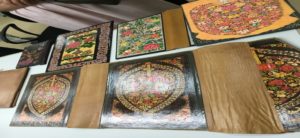The National Library of the Republic of Kazakhstan and the Preservation of Documentary Heritage
05 June 2023
Libraries are often called upon to preserve the centuries-old cultural written and printed heritage, which is the sacred repository of human knowledge. The National Library of the Republic of Kazakhstan keeps more than 7 million documents in its collections, which serve as the historical memory of the Kazakh people.
Since 1992, the National Library of the Republic of Kazakhstan has been a member of the International Federation of Library Associations and Institutions (IFLA) and received the status of the IFLA Preservation and Conservation (PAC) Regional Centre in 2008. Since then, the library has been actively cooperating with the Central Asian organisations that preserve cultural and documentary heritage. In addition to Kazakhstan, the orbit of the Regional Centre included the National Libraries of Uzbekistan, Kyrgyzstan, Tajikistan and Turkmenistan. Initially, only library specialists participated in the work of the centre, but eventually, the list of participants expanded.
The IFLA/PAC Regional Centre for Central Asia formed a library consortium in April 2022 when organisations such as the Abu Raykhon Beruni Institute of Oriental Studies of the Academy of Sciences of the Republic of Uzbekistan, the Ch.T. Aitmatov Institute of Language and Literature of the National Academy of Sciences of the Kyrgyz Republic, the Makhtumkuli Institute of Language and Literature of National Manuscripts of the Academy of Sciences of Turkmenistan joined the work of the centre. With the active participation of national libraries and other organisations of the region, the union of specialists was formed to study and preserve documentary cultural heritage.
In 2020, the Central Asian Regional Centre received the status of the IFLA/PAC expert in the field of biological and physical-chemical stabilisation of documents, which also indicates the rigorous assessment of both the Regional Centre and the National Library of the Republic of Kazakhstan in carrying out the work for the restoration and long-term preservation of documents.
Specifically, the Central Asian Regional Centre is conducting research on the reconstruction and design of elements of the Central Asian bindings. The employees of organisations belonging to the regional centre are actively studying the materials of the Middle Ages used in the production of books in different regions of Central Asia. It is known that the peoples of Central Asia have long been famous for their craft art, the creation of paper and its artistic design, respectively, and their handwritten books. The Book bindings of Central Asian origin are diverse in type, material and shape. There are leather and cardboard fabric bindings, bindings made of wood, metal and silver, etc. There are several types of leather bindings: the full leather binding, which is the single piece of leather wrapping, the cardboard walls of the manuscript, cardboard paper art bindings with the leather spine, bindings with the leather flap. It is known from the sources that Islamic bindings were distributed in the territories from Spain to Central Asia and, starting from the 5th century, were found in these territories. The design and binding of the manuscripts, calligraphic handwritings and drawings in them are great art in themselves and hold great historical value and significance.

The bindings with the leather spine were the most common type of bindings in Central Asia. The roots of the leather bindings were made from processed pet skins, and painted with natural dyes. The cardboard for binding was made from glued sheets of paper. The cardboard bindings were painted with oil paint and varnished, and subsequently decorated with monochrome or bright floral ornaments (see photo above), and often with embossed medallions. The paper intended for writing manuscripts was made of mulberry branches, silk and cotton. Recipes for colouring writing paper varied. The manuscripts were written both on strong paper of greyish, bluish and cream shades, and thin polished ivory. The ink used for writing was mainly prepared from soot and cherry gum, but sometimes there were complex recipes that included components such as ink nuts, liquid henna and etc. For the production of artistic manuscripts, rose petals were added to the paper, and various aromatic substances were added to the ink in order for the manuscript to emit a light, pleasant aroma, most often such books were intended as gifts. The existing Central Asian manuscripts are written in different languages: Chagatai, Arabic, Persian, Turkic, etc.
The promotion of historical and documentary heritage is one of the priority tasks of the libraries. The National Library of the Republic of Kazakhstan and other cultural organisations (archives, museums) have intensified their work on the study and research of the texts. Linguists, historians, and other specialists, i.e., scientists, examining rare books and manuscripts, compile catalogues of manuscripts, find previously unknown facts and events, analyse them and publish them. The Documents out of print are distributed by both the library community and the public of the city, i.e., the information received from primary sources is actively shared with the masses.
The preservation of documentary written sources means the preservation of the historical memory of the people, which can be accessed at any time. There is still a lot of handwritten documents that are waiting to be discovered and, by teaming up with the laboratories of libraries, museums and archives of the world, it is possible to jointly carry out research, conservation and restoration work of the documentary written heritage.
Modern libraries are trying to preserve and multiply that “island” of knowledge and wisdom accumulated over centuries in books and manuscripts, as well as preserve and remain “on the waves” of modern life, becoming the centre of leisure and recreation for many people, giving them warmth, comfort and joy, which are sometimes so lacking in our fleeting life.
Contributed by Sarsenbayeva Botakoz Shagalievna, National Library of the Republic of Kazakhstan.